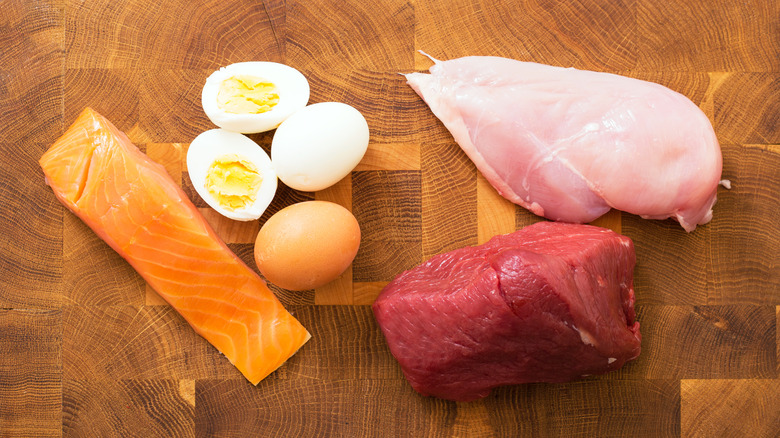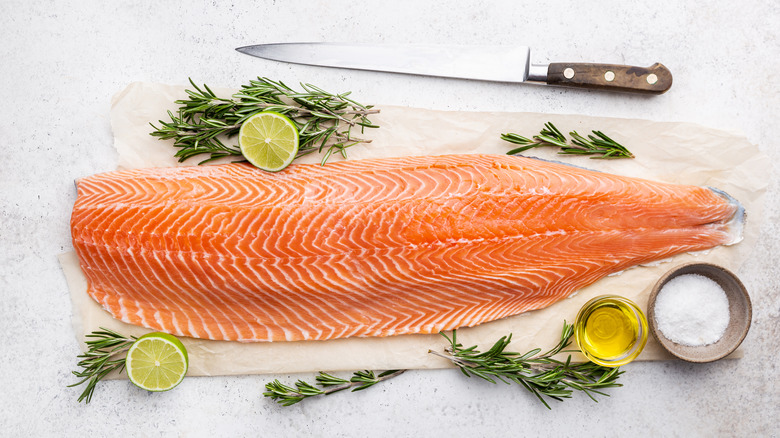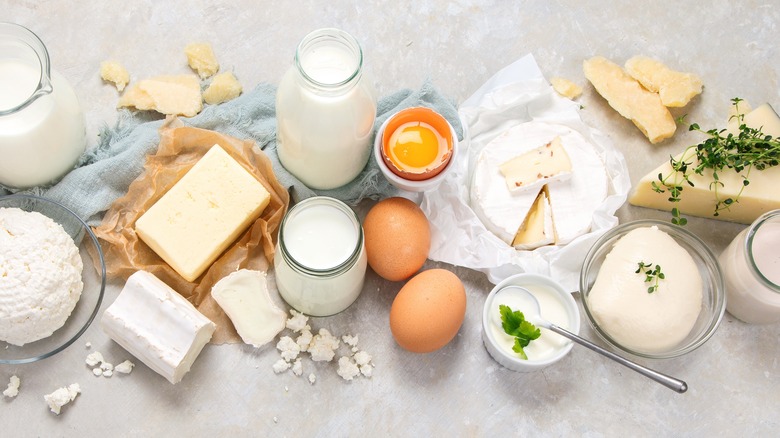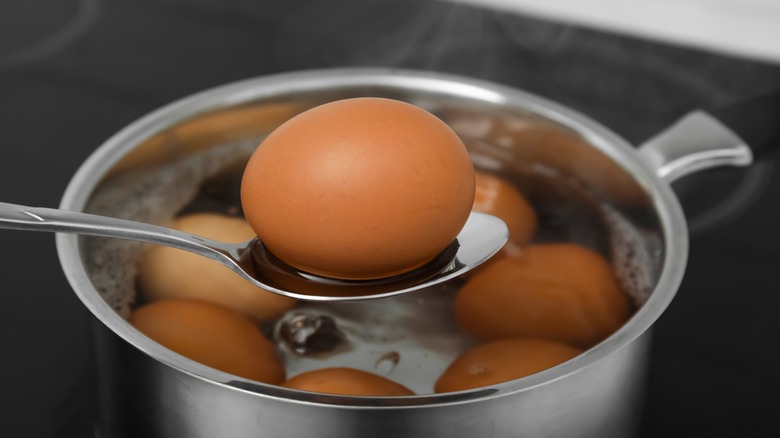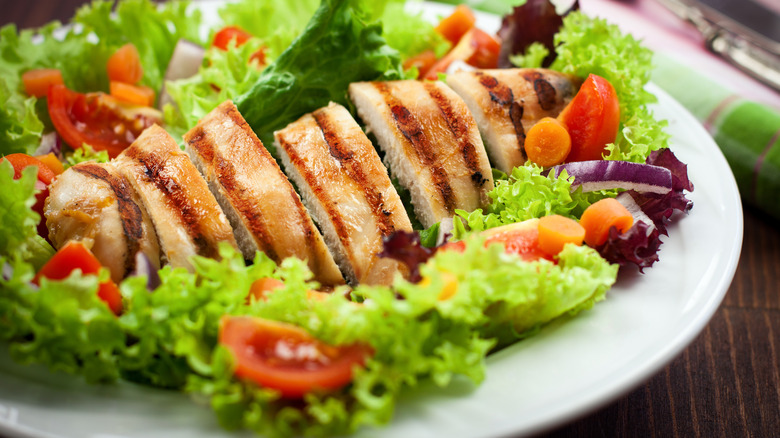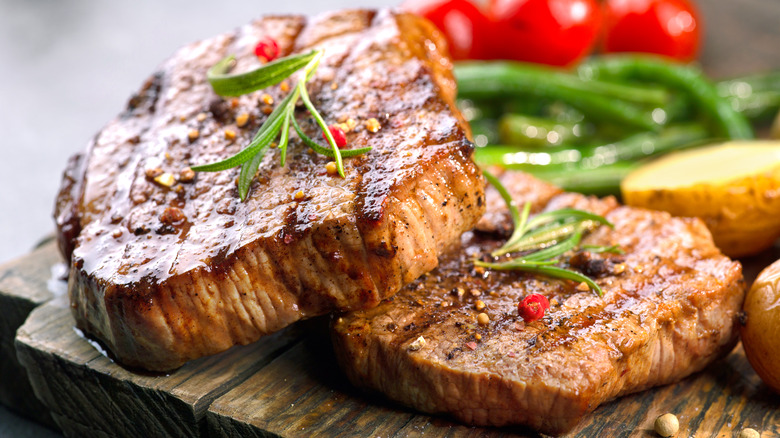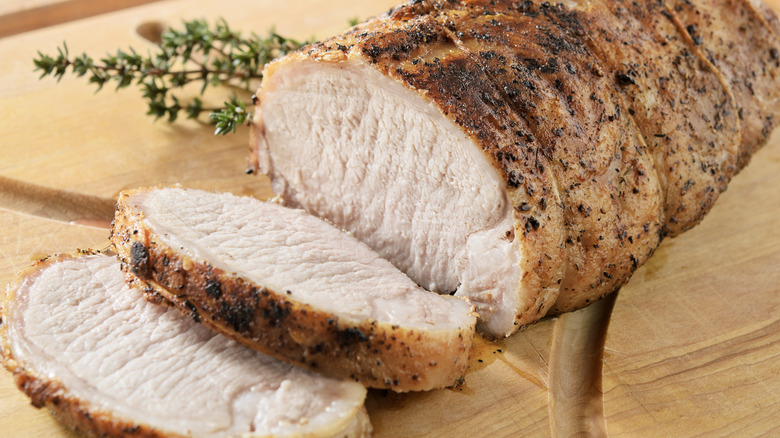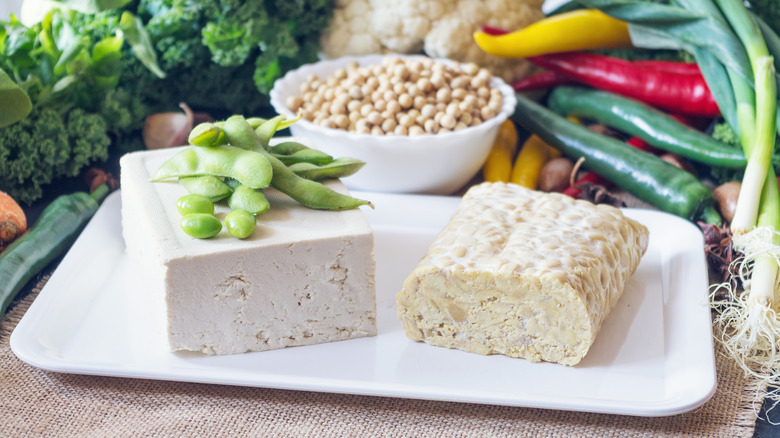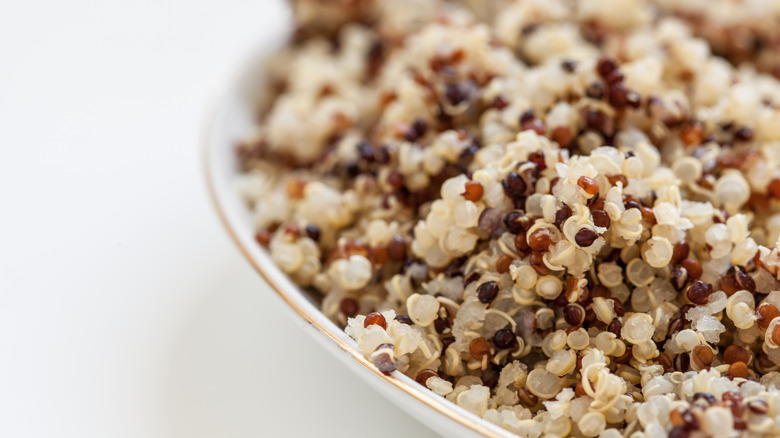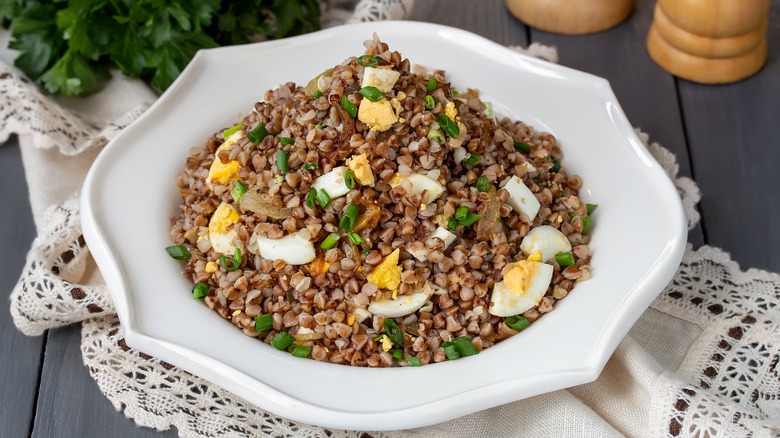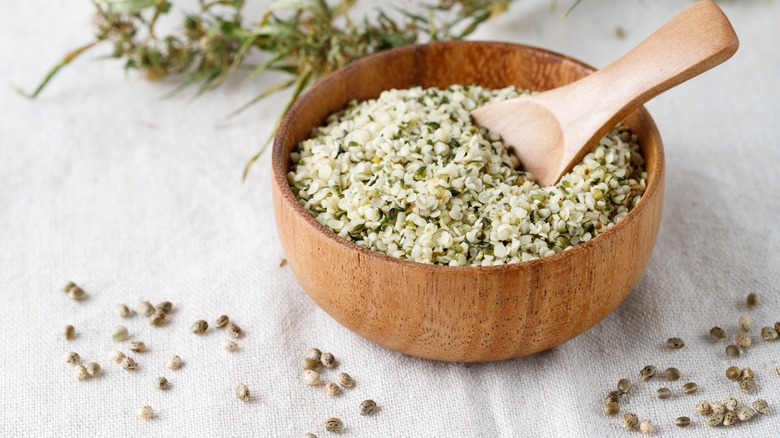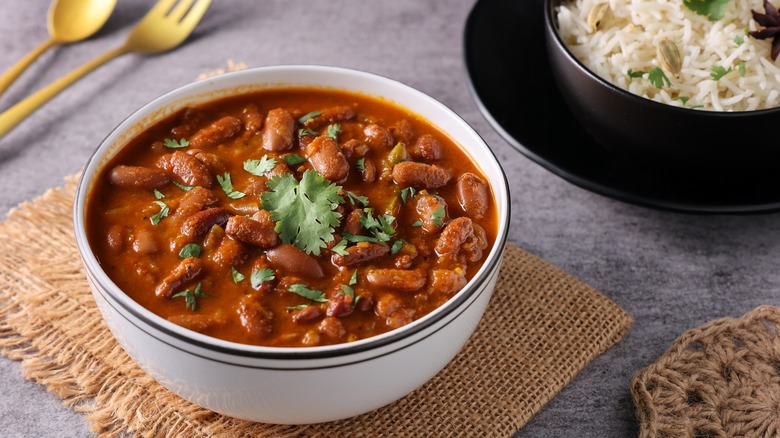Complete Proteins You Should Add To Your Diet For Better Health
There's so much to know about protein. Protein supports our muscles, bones, and hair. The amino acids that protein is composed of are necessary for tissue repair and the transport of nutrients. Amino acids also assist in the makeup of the hormones and enzymes necessary for our body's many functions for well-being.
On a more macro level, protein supports energy levels and keeps us satisfied (per Asia Pacific Journal of Clinical Nutrition). And, when you combine protein with a source of carbs, it may help prevent blood sugar spikes (per The Journal of Nutrition). Blood sugar spikes can leave you feeling moody and fatigued, according to Scrubbing In.
How much protein do you need? To meet your basic nutrition needs, let 0.36 grams of protein per pound of body weight be your guideline. But, because everyone is different, a registered dietitian can help fine-tune your individual needs.
To get you started, we've got some excellent sources of complete protein you can include in your diet. But first, we'll define what a complete protein is.
What is a complete protein?
Your body needs 20 amino acids to perform the vital functions of living. Fortunately, 11 of these are produced by the body itself. This leaves nine that we have to obtain from our diet. A complete protein has these nine essential amino acids — histidine, leucine, isoleucine, tryptophan, methionine, threonine, phenylalanine, and valine. There are other types of proteins that don't have all nine, but if you eat a variety of whole foods, you can still meet your needs.
Unlike most plants, animal sources are complete proteins. That includes fish, poultry, beef, and animal-derived proteins like milk and eggs. Plants may carry some, but not all, of the essential nine amino acids. Fortunately, you can include a variety of plants in your diet to obtain all nine. Some examples of incomplete proteins include seeds, nuts, legumes, vegetables, and whole grains. Although there are fewer complete proteins from the plant kingdom, some whole grains like quinoa and buckwheat have all nine essential amino acids.
Fish
The American Heart Association recommends including fish twice per week as a part of your healthy diet. A complete protein, fish also brings to the table a variety of vitamins and nutrients, including omega-3s, zinc, iron, magnesium, and potassium.
You may already know that consuming fish may benefit your heart and your brain, thanks to its omega-3 content (per Washington State Department of Health). Since our bodies can't produce omega-3s, we must get them through our diet. You will find these antioxidant nutrients more concentrated in fattier fish options such as salmon.
Sure, farmed salmon may look more vibrant (due to dyes used in manufacturing) and it may taste milder and juicier. But, if you are concerned about farmed fish being tainted with chemicals and antibiotics, there are plenty of wild sources available. And, as a bonus, wild fish typically contain more omega-3s, according to UCLA Health. Marinating these wild-caught species may tone down its strong taste and provide a delicious umami experience. Coating it with some oil to create a barrier may prevent it from becoming dry (via Wild Alaskan Company). You may also leave the skin on as an additional barrier to keep it moist while cooking.
Other great fish options include wild-caught tuna fish, trout, sardines, and mackerel.
Dairy
Next, let's bone up on the many benefits of protein-rich dairy! In addition to bone-supportive nutrients — calcium, magnesium, phosphorus, and vitamin D — it also is a source of vitamin A, choline, and essential B vitamins (B12 and riboflavin). All these nutrients support overall health and maintenance needs. What's more, emerging evidence suggests consuming dairy foods such as yogurt, milk, and cheese may actually reduce the risk for systemic inflammation, according to a 2021 review in Advances in Nutrition.
You may have been told that the lactose in dairy will make you gassy. That's because you may not produce enough of the enzyme lactase. Lactase is needed in order for you to fully digest the lactose in milk and soft, fresh cheeses — so it could result in gas, bloating, and diarrhea when you eat these foods. If you are concerned about milk's lactose content, you can opt for lactose-free milk. Or you might consider a digestive enzyme supplement like Lactaid to prevent stomach distress. Cultured foods like yogurt may be more easy for you to tolerate as they are much lower in lactose (and you will benefit from their probiotic content). Hard, aged cheeses are also generally better tolerated because the bacteria in them deplete the lactose content (via American Chemical Society).
And, just in case you need further convincing, dairy is an easy, convenient way to obtain a complete protein. Think: a glass of milk, a serving of yogurt, or an ounce or two of cheese in your meal or snack combo. You don't even have to cook it. Still, there are some delicious baking and stove-top recipes that use milk or cheese.
Eggs
Eggs are a compact source of nutrition. And at just 77 calories, one egg provides 6 grams of complete protein, 5 grams of heart-healthy fat, and a plethora of vitamins and minerals including B5, B6, B12, calcium, zinc, and brain-supportive choline. Eggs are also good sources of the antioxidant nutrients lutein and zeaxanthin — both of which are beneficial to your eyesight.
And, if you are managing your cholesterol, the egg can be a good fit for your heart-healthy diet. Contrary to dated research, eggs can have a protective effect against atherosclerosis, according to a 2018 article in Nutrients. This is in part due to its role in reversing cholesterol transport. But it may also be due to the egg's anti-inflammatory properties. And while the egg contains 200 milligrams of cholesterol, there is more to it than just the cholesterol concentration that affects cholesterol levels. In fact, the human body produces cholesterol naturally, and only a quarter of serum cholesterol is derived from the foods we consume. That said, you don't want to go overboard with any type of food (whether considered healthy or not-so-healthy).
The Mayo Clinic suggests that healthy individuals may consume as many as seven eggs per week. That could reasonably translate to one egg per day. So long as you aren't regularly combining eggs with foods such as bacon, butter, and cheese, enjoying one egg a day can be okay. In fact, those highly saturated foods should be eaten sparingly. The egg itself is low in saturated fats.
Poultry
You may also want to add some poultry to your menu. In addition to its status as a complete protein, poultry is a good source of iron, zinc, B12, and iodine, and even contains some omega-3s. Though it may be minimal (3 ounces of chicken contains just 0.03 grams of omega-3s, according to WebMD), every little bit counts. And you can always choose other omega-3 sources like walnuts and olive oil to enhance your poultry-inspired meal.
So, let's talk about two of the most common sources of poultry — turkey and chicken.
Chicken is one of the most versatile animal proteins. Just look at some of your favorite dishes. From roasted whole chicken to hearty salads, sandwiches, stir-fries, and chicken parmesan, you can incorporate chicken in almost any entrée or dish. To keep it healthy, eat it skinless and opt for cooking methods like sautéing, poaching, baking, roasting, stir-frying, and steaming — instead of frying.
Turkey might sound less common since you probably only roast a whole turkey once or twice a year — think about your holiday meals. But don't forget those luncheon meats that make building your lunches so simple and convenient. For your best health, opt for turkey slices that are nitrate-free and have minimal additives and preservatives.
Interesting fact: You won't find any hormones or steroids in any poultry that you buy, regardless of its claim (or lack thereof). The U.S. Food and Drug Administration (FDA) strictly prohibits any artificial or added hormones or steroids in the production of U.S. poultry (via National Chicken Council). So, when you see "raised without hormones" or "no hormones added" on the package, it's merely a redundancy.
Lean beef
Does the mention of red meat make you feel concerned? Sure, there have been several studies indicating that red meat consumption is associated with increased risk for stroke. Red meat can also be high in saturated fats which is linked to high cholesterol. But it is important to remember that, in addition to its protein content, meat can be a valuable source of vitamin B12, iron, and zinc — nutrients that may be lacking in vegan diets.
So, limit animal proteins, but don't completely shun them from your diet. In fact, the 2020-2025 Dietary Guidelines suggest animal sources, including lean red meat, may be included as part of a healthy dietary pattern. According to the U.S. Department of Agriculture (USDA), "Lean means that 100 grams of beef (about 3 ½ ounces) have less than 10 grams of fat, 4.5 grams or less of saturated fat, and less than 95 milligrams of cholesterol."
For your best health, opt for leaner cuts of meat and limit your consumption to three (4- to 6-ounce) portions of red meat per week, suggests the World Cancer Research Fund International. Some leaner cuts include top sirloin, eye of round roast, bottom round roast, chuck shoulder, and lean ground beef (via USDA). Choose little, if any, forms of processed red meat.
Pork
Some pork is fatty, but you can easily go lean to reap the benefits of pork, aka "the other white meat." Pork loin is a low source of saturated fat. You can even trim the fillets to keep saturated fat low. Pork is a natural, complete protein that contains nutrients that benefit your immunity. These include vitamins B6 and B12, zinc, and selenium. B6 and B12 are also beneficial for keeping your energy levels optimal.
Sure, you can always enjoy the leaner pork loin cut with veggies and a starch. But you can easily incorporate pork into your diet in so many interesting ways. It can replace the more typical chicken, beef, or tofu in some of the most common crowd-pleasers. Add pork to your stir-fries. Use finely diced pork with your baked beans. Add chopped pork to veggie-rich omelets. Toss it in your Cobb salad. Shred it for a Tuesday Taco option. Additionally, you can use it as a protein topper for your pizza.
Soy
Let's hear it for soy foods! As complete proteins, they can rock the nutrition in your meatless meals.
Soy is a rich source of isoflavones — antioxidant nutrients that may benefit you with their antimicrobial and anti-inflammatory qualities (via a 2016 review in Nutrients). As phytoestrogens, they have estrogen-like effects. Isoflavones may also help reduce visceral fat and blood lipids — a quality that can reduce heart disease risk.
And yet, critics suggest these very same compounds may have a role in thyroid disruption, the proliferation of breast cancer, and even dementia. Should you be concerned? According to the Harvard T.H. Chan School of Public Health, there isn't enough substantial research to support these negative claims. In fact, you may safely consume moderate amounts of this complete protein several times a week. Suggested serving sizes include 1 cup of soy milk, 3 ounces of tofu or tempeh, and ½ cup of edamame.
And just because tofu, edamame, and tempeh are plant foods, that doesn't mean they can't be satisfying. Sliced, chopped, or crumbled, they can easily be substituted for chicken, pork, or beef. In fact, they can take on the flavors of your favorite carnivore dishes — thanks to their relatively mild flavor. While tempeh may be best marinated, tofu is much more versatile. As far as edamame, it's perfect for a satiating snack and can be a great protein boost to your leafy green salads. Just use your imagination; any of these soy options can be a part of a delicious, nutritious meal.
Quinoa
Quinoa is classified as a whole grain. However, it is technically a seed that hails from the same family as spinach, chard, and beets (via BBC Good Food).
It may be no surprise that there are health benefits of quinoa — that's because it's so nutrient-dense. It is not only an excellent source of fiber, it's also high in protein, and it is a protein with all nine essential amino acids. As such, it is a complete protein. One cup of cooked quinoa has 8.14 grams of protein, 5.18 grams of dietary fiber, and a host of nutrients including magnesium, potassium, selenium, and zinc (via USDA). And you'll also get plenty of iron and B vitamins, too. And it is naturally gluten-free.
You may use quinoa as a swap for rice, bulgur, grits, or barley. Or toss it in your entrées or salads to add a textural appeal. It pops when cooked, leaving a visible ring around each individual "grain," giving its relatively soft consistency a delicate, light crunch.
Buckwheat
If you haven't eaten buckwheat, there are plenty of nutritional reasons to try it. As a whole grain and a complete protein, you get "two bangs for your buck" when it comes to rounding out your meal. And its value goes well beyond its macronutrient content as both a protein and a carbohydrate.
According to a 2001 article in the Journal of Agriculture and Food Chemistry, buckwheat may help lower postprandial insulin response and keep blood sugar levels from spiking. This whole grain may also benefit by acting as a prebiotic to support healthy gut flora (via a 2023 review in Food Science & Nutrition). What's more, it is a source of antioxidants and bioactive components to protect against chronic disease.
When it comes to cooking, it's quite versatile. As the buckwheat groats cook down to a soft grain, it is ideal for hot cereal on a cooler morning and makes just as good of a side as pasta or rice. Like most grains, it can easily take on additional flavors due to its starchy and relatively mild taste. Have you tried brisket with kasha varnishkes? The traditional Jewish dish is made with buckwheat groats and butterfly pasta and flavored with a savory brisket gravy.
Hemp seeds
Hemp seeds are an easy way to boost the protein in your meals. Whether you sprinkle them into your salads, adorn your smoothie bowls, or use them to garnish your veggies, there are plenty of ways you to enjoy them.
Just 1 ounce (approximately 3 tablespoons) of hemp seeds contains a whopping 9.5 grams of protein (via USDA). And, even better, hemp seeds are a complete protein — with all nine essential amino acids, according to Medical News Today. They are a source of fiber, B vitamins, iron, and zinc. Did you know that hemp seeds are also rich in anti-inflammatory omega-3s? All the more reason to try them.
If you are wondering what hemp seeds taste like — they are mild and nutty with a flavor that lies between that of a sunflower seed and a pine nut, according to Green Lotus Hemp. They are often enjoyed raw (just out of the package), but you can increase their nuttiness by toasting them in a skillet over low heat. You may even consider using hemp seeds to replace the bread coating on your fish or chicken.
The good news is that hemp seeds may last in the cupboard for up to four months (per Green Lotus Hemp). But, if you want to extend their shelf life, consider refrigerating them because their fatty acid content can degrade over time.
Creating a complete protein from two incomplete sources
If you don't eat animal or animal-derived foods, you can build a complete protein from two incomplete sources. That's because the amino acid(s) lacking in one incomplete protein may be more plentiful in another and vice versa. As such, they complement each other.
Beans with rice, hummus and pita, and nut butter on whole-grain toast are some complete-protein combinations. Other ways to obtain all nine essential amino acids include adding protein-rich fruits and leafy greens into your smoothies, sprinkling chia and other seeds in your cereals and snacks, and topping legume-based soups (such as lentil soup) with sunflower seeds.
The good news is that you don't necessarily need to get your complete protein in a single meal or obsess about meeting your daily requirements. "Instead, aim for variety in your whole day," licensed and registered dietitian Shayna Komar told Piedmont Healthcare.
So, whether you eat beans and rice (together or at separate meals) or snack on nuts or seeds, if you aim for a plentitude and variety of plant foods throughout your day, you should be okay.

